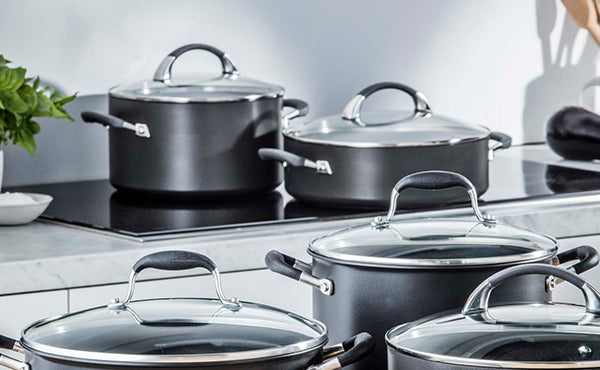When I was a kid, I was obsessed with magic. My poor, long-suffering family were forced to spend untold hours camped on the living room couch, pretending, with varying degrees of success, to appear thrilled and mesmerised as I pulled yet another stuffed rabbit out of a beaten-up top hat. Magic paraphernalia littered every corner of my existence and frequent shrieks of frustration were heard emanating from the laundry, where my mother had discovered yet another hidden stack of cards had found its way undetected into the washing machine to be eviscerated by the spin cycle.
Many years later, I was reminded of my long-since faded dedication to mystical arts when I first witnessed an induction cooktop in action. Here, I wondered in amazement, was pure magic. I watched water boiling in a pot faster than I had ever experienced, while the element remained cool to the touch. Surely there must be some form of culinary hocus-pocus at play here? The plot thickened further when I found that not all cookware works with induction cooktops. I asked around, and many of my friends and colleagues appeared to consider induction cookware some kind of mythical beast that difficult to locate and even more challenging to capture. This only served to increase the induction mystique in my mind.
The truth is that choosing the best cookware for induction cooktops is far less complicated than it would seem and involves precisely zero sorcery, Wicca or enchantment whatsoever. However, before I break the sacred magician’s rule and reveal how we perform this gastronomic sleight-of-hand, let’s first take a quick look at what Induction cooking is, and why it is rising in popularity:
How Does Induction Cooking Work?
The reality is somewhat less exotic, although undoubtedly ingenious: We all understand how traditional cooking methods work, right? You have a flame or electric coil that heats the base of your pan or pot, which then transfers the heat to the food. By contrast, induction cooktops create an electromagnetic field, which excites the iron or steel atoms in the base of the cookware, causing them to heat up. This means the cookware itself becomes the primary heat source and cooks the food directly, rather than indirectly.
What Are the Advantages of Induction Cooking
1. Efficiency
Anyone who cooks with gas knows that it’s a fabulous way to heat your kitchen in winter. That’s because only 38% of the heat from gas reaches the food in the pan. Electric is somewhat higher at 70% efficiency. Due to the direct heating method described above, induction cooking ensures that over 90% of the energy from the electromagnetic field reaches the food.
2. Speed
As a result, food cooks more quickly. In rigorous testing, induction cooktops have been shown to bring water to the boil in almost half the time of electric and a third of gas.
3. Precision & Flexibility
Induction allows incredible control over the cooking process. The operating temperature range is far superior to gas and comparable to electric. However, unlike electric, there is no annoying lag when adjusting temperatures and you can heat up and cool down almost instantaneously. This ensures outstanding control over the cooking process. This is particularly handy for cooking delicate foods which require gentle cooking at lower temperature.
4. Ease of Cleaning
As the element does not heat up, cleaning is a cinch! No more baked on gunk.
5. Safety
Similarly, no burns or risk of fire.
6. Energy Savings
Due to the efficiency described in point 1 above, it required far less energy to create heat, meaning savings on your monthly energy bills. With the costs of gas and electricity rising so acutely in Australia, this is a huge selling point.

Choosing the Right Cookware for an Induction Cooktop
Ok, now that you’re thoroughly convinced that induction is the answer to all your culinary prayers, let’s return to our original question: how to navigate the seemingly murky world of induction cookware? As anyone who passed grade 6 science will know, magnets work on metals. That’s glass and ceramic out, right there.
You might think this is the end of the story, but this is where the confusion sets in. Some metals commonly used in cookware are not easily magnetised; particularly copper and aluminium, making them incompatible with induction cooking. Just to add a bit more intrigue, much stainless-steel cookware is constructed with layers of copper or aluminium, which may or may not affect their magnetic properties. Hang on! Didn’t we say this was going to be simple? Well, here’s the clincher: hold a magnet up to the base of your cookware. If it sticks, it’s induction compatible. If not, you won’t be able to use it. We told you! It’s genuinely that simple. A good rule of thumb is as follows:
- Stainless: Usually fine. Sometimes combined with an aluminium layer in the base to assist with improved heat conductivity, so best to check.
- Aluminium: Usually no good, but many manufacturers now include a layer of steel in the base to make it compatible with induction.
- Iron: Works beautifully. In fact, cast iron is often easier to use on an induction cooktop than on gas or electric, as it heats much faster.
Where to Get the Best Induction Cookware Sets
At Cookware Brands, of course! Our extensive range of Australia’s finest cookware, including some of the world’s biggest names, includes numerous induction-compatible models. Check out our store to find the induction-friendly cookware to suit your needs, and abracadabra, you’ll be cooking like magic!

